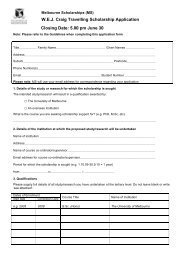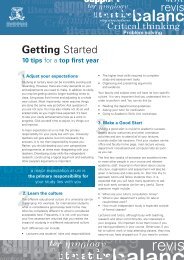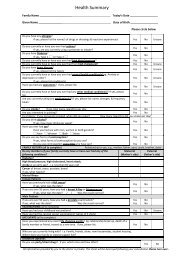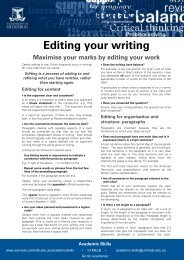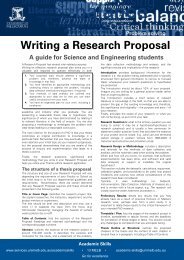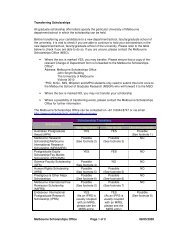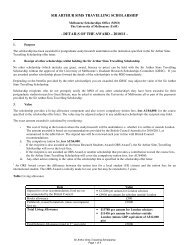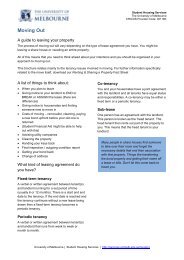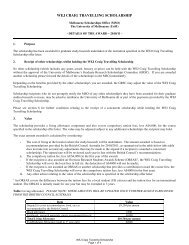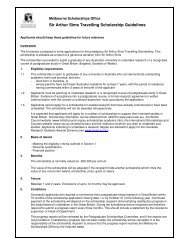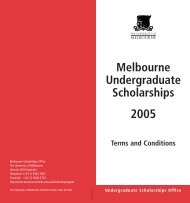a growing experience - Student Services - University of Melbourne
a growing experience - Student Services - University of Melbourne
a growing experience - Student Services - University of Melbourne
You also want an ePaper? Increase the reach of your titles
YUMPU automatically turns print PDFs into web optimized ePapers that Google loves.
HEALTH AND WELL-BEING OF INTERNATIONAL STUDENTSPerceived drug and alcohol use, together with involvement in gambling/smoking, areconsistent predictors <strong>of</strong> health-related behaviours. Each pair <strong>of</strong> these behaviourspredicts the third, thus the three form a tightly-knit, interdependent cluster <strong>of</strong> riskybehaviours. Perceived drug use is the strongest predictor, involvement ingambling/smoking the next strongest, while perceived alcohol use is the weakest <strong>of</strong>the three. Needless to say, they are all positive predictors <strong>of</strong> one another. Alcoholuse also acts as a significant positive predictor <strong>of</strong> self-harm. Excessive alcohol usecan itself constitute a form <strong>of</strong> self-harm, a maladaptive strategy for coping withdistress. The Perceptions <strong>of</strong> Gambling/Smoking scale is also a strong negativepredictor <strong>of</strong> condom use; high involvement in gambling/smoking is associated withless frequent use <strong>of</strong> condoms.The Depression scale is another common and consistent predictor <strong>of</strong> well-being in thedomain <strong>of</strong> health and health-related behaviour. We saw earlier that depression is asignificant negative predictor in the domain <strong>of</strong> daily life and study in <strong>Melbourne</strong>.Here depression is a negative predictor <strong>of</strong> self-esteem and a positive predictor <strong>of</strong> druguse, alcohol use and self-harm. Its strength as a predictor is highest for self-esteemand self-harm.Perceived academic progress plays a role in students’ well-being in the domain <strong>of</strong>health and health-related behaviours. It is a significant negative predictor <strong>of</strong>depression, general stress and self-harm, and a positive predictor <strong>of</strong> self-esteem.<strong>Student</strong>s who feel they are progressing as well as or better than expected have lowlevels <strong>of</strong> depression, general stress and self-harm, but high levels <strong>of</strong> self-esteem. It isthe students who feel they are doing worse than expected academically who are indifficulties. The strongest contribution <strong>of</strong> perceived academic progress is to thedimension <strong>of</strong> depression, with its contribution to other aspects <strong>of</strong> well-being beingweaker. However, it is a variable that does act as a significant predictor in aconsiderable range <strong>of</strong> areas <strong>of</strong> well-being in different domains.Several other predictors play a less consistent role in this domain - connectedness,abuse and distress, gender, anxiety and age – each helping to account for variance inone or two aspects <strong>of</strong> well-being. Different variables concerning cultural backgroundalso act as predictors, but for only half <strong>of</strong> the aspects <strong>of</strong> well-being in this domain.Being from an Asian country is a positive predictor <strong>of</strong> anxiety, participation in aFoundation Studies program is a negative predictor <strong>of</strong> self-esteem, speaking a LOTE<strong>of</strong>f campus is positive predictor <strong>of</strong> perceiving health interference in study, being froma non-Asian country is a positive predictor <strong>of</strong> drug use, and being an English speaker<strong>of</strong>f campus is a positive predictor <strong>of</strong> alcohol use. Although these variables seem toplay a less consistent part in students’ well-being in this domain, when they arecombined with or mediated by the cultural stress variable, it can be seen that culturalbackground does play an important role in accounting for variation in students’perceptions <strong>of</strong> well-being in the domain <strong>of</strong> health and health-related behaviour.The amount <strong>of</strong> variation in students’ well-being accounted for in the different aspects<strong>of</strong> health and health-related behaviour ranges from a low <strong>of</strong> 7.9 per cent for condomuse to 30.4 per cent for Depression. The data provide a very limited understanding <strong>of</strong>patterns <strong>of</strong> condom use. The highest percentages <strong>of</strong> variance are accounted for in thethree DASS scales and the three main risk-taking behaviours, drug use, alcohol useand gambling/smoking. Once again, the strongest predictors are psychologicaldimensions rather than demographic variables.Rosenthal, Russell & Thomson, 2006 156



